Influence of 4D Modern Technology on Construction Project Performance
VerifiedAdded on 2021/05/27
|12
|3622
|320
Project
AI Summary
This research proposal investigates the impact of 4D modern technology on the performance of construction projects. It begins with a research roadmap outlining the stages from topic identification to final documentation. The abstract highlights the increasing importance of technologies like 4D modeling and simulation in construction, emphasizing their potential to improve structural designs, communication of risks, and resource management. The proposal aims to address concerns about the performance of 4D technology by analyzing its influence on structural designs, risk communication, and resource scheduling. The study will employ an experimental research design, comparing control and experimental groups using advanced analytical software to assess performance based on rubrics like durability, texture, leveling, aesthetics, and conformance. Data will be collected through observational checklists and analyzed using inferential statistics. The proposal emphasizes the significance of research and development in the construction industry, referencing the European Construction Technology Platform and the Australian agencies' strategies for project performance improvement. The study explores the application of 4D planning in architectural designs, its benefits in construction phasing simulation, and its role in optimizing schedules and managing project teams. It also acknowledges the limitations of 4D modeling, such as complexity and dependence on user specifications. The research aims to answer the question of how modern aspects influence the performance of constructed projects and is guided by the objectives to analyze the impact of 4D models on structural designs, risk communication, and resource scheduling. The methodology will employ action type of research to find answers on how 4D modern aspects in technology influences performance of construction projects.
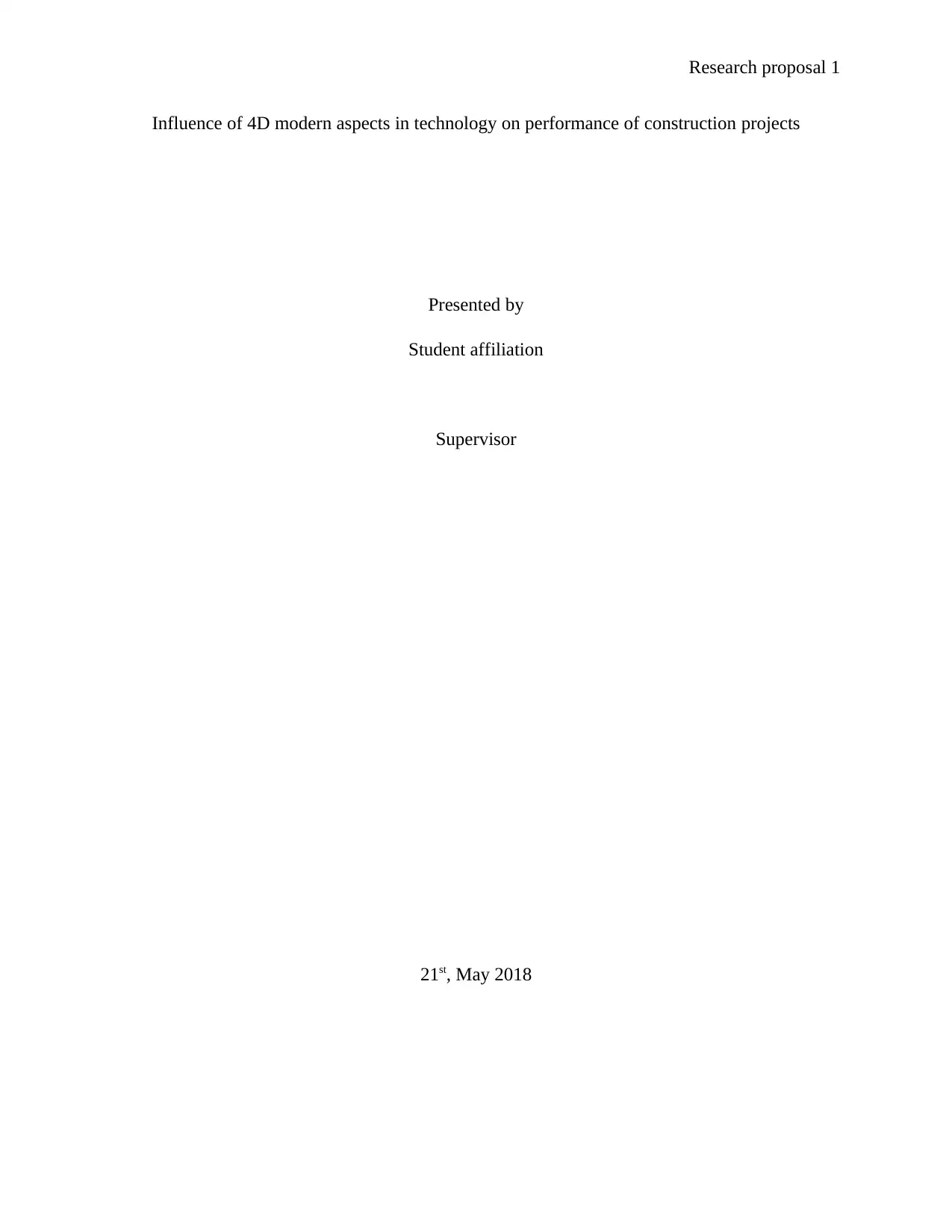
Research proposal 1
Influence of 4D modern aspects in technology on performance of construction projects
Presented by
Student affiliation
Supervisor
21st, May 2018
Influence of 4D modern aspects in technology on performance of construction projects
Presented by
Student affiliation
Supervisor
21st, May 2018
Paraphrase This Document
Need a fresh take? Get an instant paraphrase of this document with our AI Paraphraser
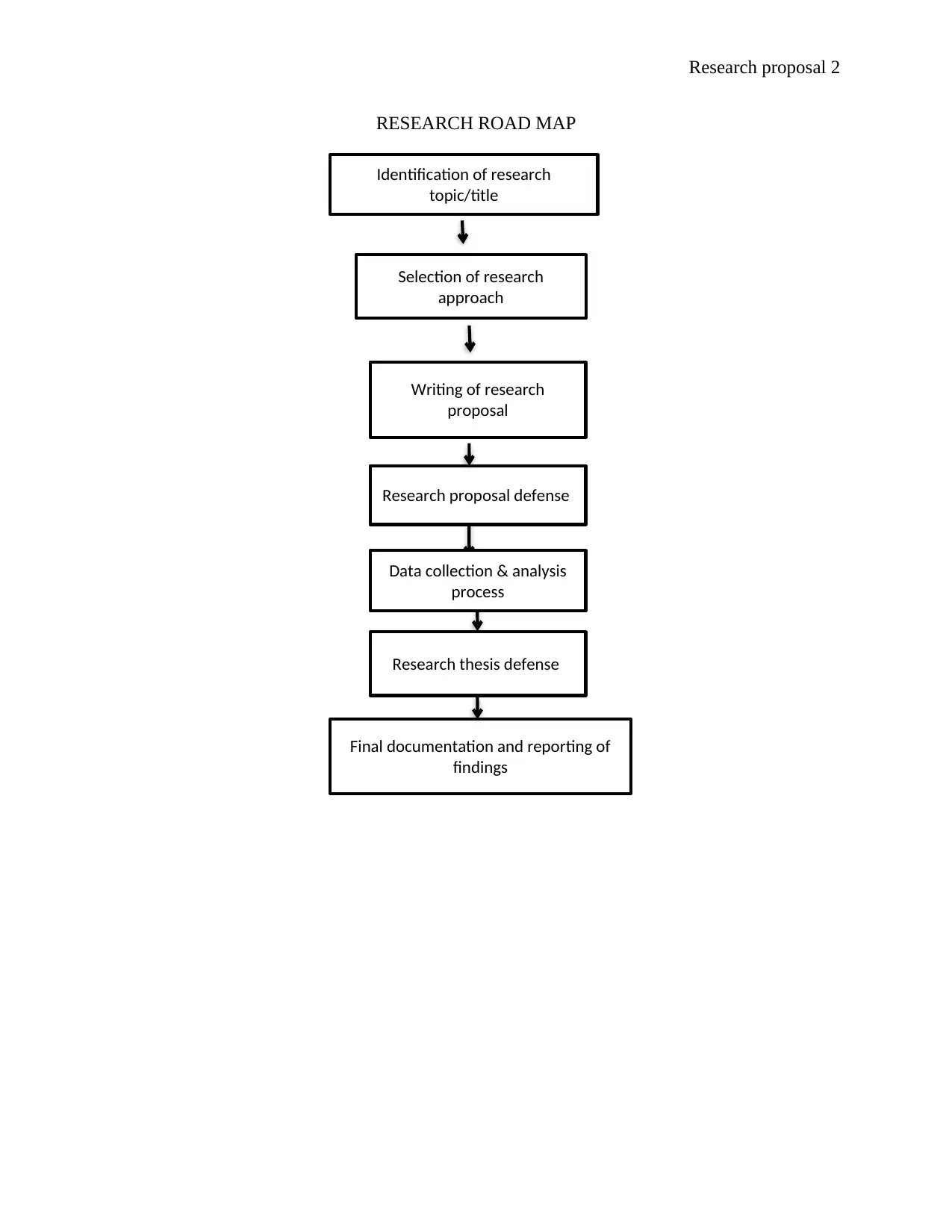
Research proposal 2
RESEARCH ROAD MAP
Identification of research
topic/title
Selection of research
approach
Writing of research
proposal
Research proposal defense
Data collection & analysis
process
Research thesis defense
Final documentation and reporting of
findings
RESEARCH ROAD MAP
Identification of research
topic/title
Selection of research
approach
Writing of research
proposal
Research proposal defense
Data collection & analysis
process
Research thesis defense
Final documentation and reporting of
findings
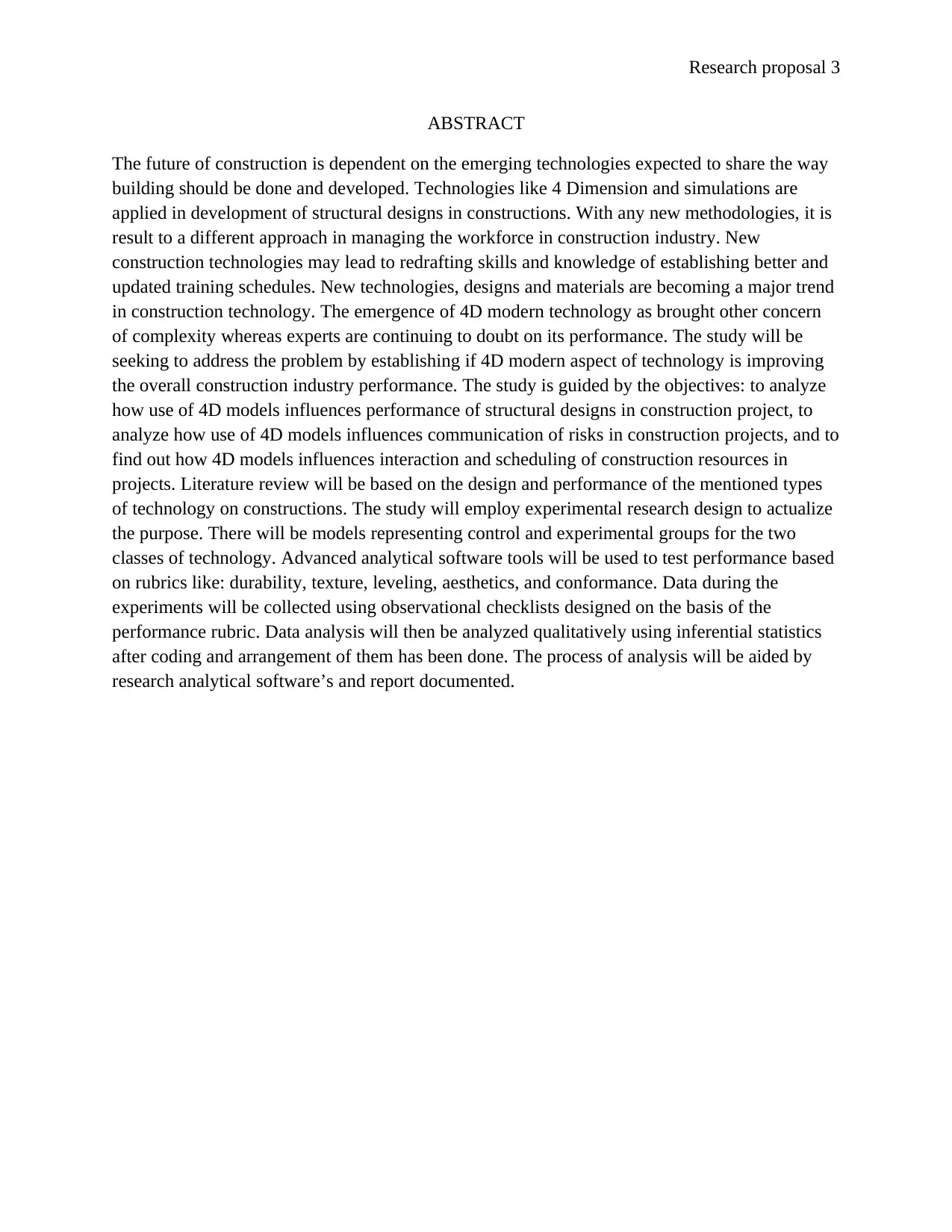
Research proposal 3
ABSTRACT
The future of construction is dependent on the emerging technologies expected to share the way
building should be done and developed. Technologies like 4 Dimension and simulations are
applied in development of structural designs in constructions. With any new methodologies, it is
result to a different approach in managing the workforce in construction industry. New
construction technologies may lead to redrafting skills and knowledge of establishing better and
updated training schedules. New technologies, designs and materials are becoming a major trend
in construction technology. The emergence of 4D modern technology as brought other concern
of complexity whereas experts are continuing to doubt on its performance. The study will be
seeking to address the problem by establishing if 4D modern aspect of technology is improving
the overall construction industry performance. The study is guided by the objectives: to analyze
how use of 4D models influences performance of structural designs in construction project, to
analyze how use of 4D models influences communication of risks in construction projects, and to
find out how 4D models influences interaction and scheduling of construction resources in
projects. Literature review will be based on the design and performance of the mentioned types
of technology on constructions. The study will employ experimental research design to actualize
the purpose. There will be models representing control and experimental groups for the two
classes of technology. Advanced analytical software tools will be used to test performance based
on rubrics like: durability, texture, leveling, aesthetics, and conformance. Data during the
experiments will be collected using observational checklists designed on the basis of the
performance rubric. Data analysis will then be analyzed qualitatively using inferential statistics
after coding and arrangement of them has been done. The process of analysis will be aided by
research analytical software’s and report documented.
ABSTRACT
The future of construction is dependent on the emerging technologies expected to share the way
building should be done and developed. Technologies like 4 Dimension and simulations are
applied in development of structural designs in constructions. With any new methodologies, it is
result to a different approach in managing the workforce in construction industry. New
construction technologies may lead to redrafting skills and knowledge of establishing better and
updated training schedules. New technologies, designs and materials are becoming a major trend
in construction technology. The emergence of 4D modern technology as brought other concern
of complexity whereas experts are continuing to doubt on its performance. The study will be
seeking to address the problem by establishing if 4D modern aspect of technology is improving
the overall construction industry performance. The study is guided by the objectives: to analyze
how use of 4D models influences performance of structural designs in construction project, to
analyze how use of 4D models influences communication of risks in construction projects, and to
find out how 4D models influences interaction and scheduling of construction resources in
projects. Literature review will be based on the design and performance of the mentioned types
of technology on constructions. The study will employ experimental research design to actualize
the purpose. There will be models representing control and experimental groups for the two
classes of technology. Advanced analytical software tools will be used to test performance based
on rubrics like: durability, texture, leveling, aesthetics, and conformance. Data during the
experiments will be collected using observational checklists designed on the basis of the
performance rubric. Data analysis will then be analyzed qualitatively using inferential statistics
after coding and arrangement of them has been done. The process of analysis will be aided by
research analytical software’s and report documented.
⊘ This is a preview!⊘
Do you want full access?
Subscribe today to unlock all pages.

Trusted by 1+ million students worldwide
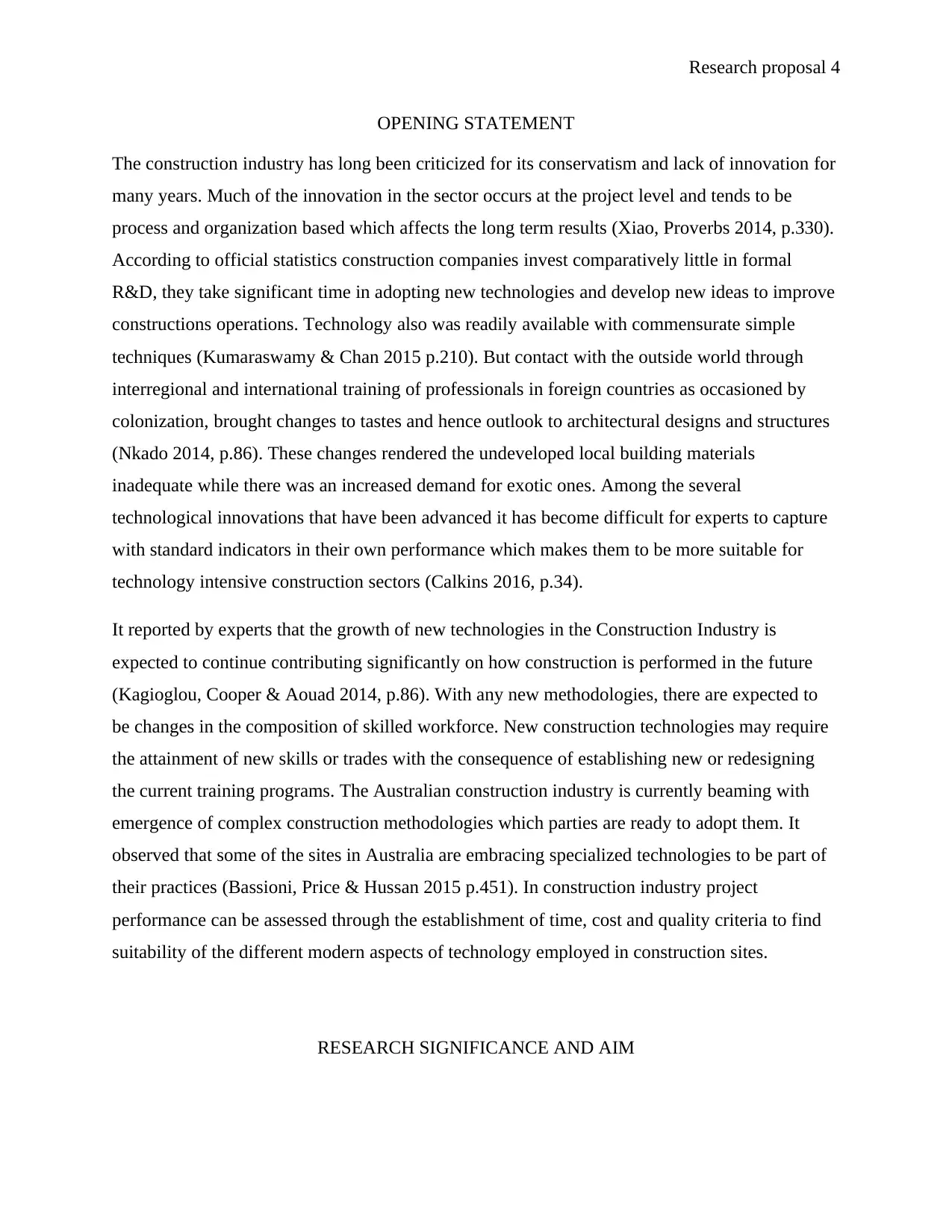
Research proposal 4
OPENING STATEMENT
The construction industry has long been criticized for its conservatism and lack of innovation for
many years. Much of the innovation in the sector occurs at the project level and tends to be
process and organization based which affects the long term results (Xiao, Proverbs 2014, p.330).
According to official statistics construction companies invest comparatively little in formal
R&D, they take significant time in adopting new technologies and develop new ideas to improve
constructions operations. Technology also was readily available with commensurate simple
techniques (Kumaraswamy & Chan 2015 p.210). But contact with the outside world through
interregional and international training of professionals in foreign countries as occasioned by
colonization, brought changes to tastes and hence outlook to architectural designs and structures
(Nkado 2014, p.86). These changes rendered the undeveloped local building materials
inadequate while there was an increased demand for exotic ones. Among the several
technological innovations that have been advanced it has become difficult for experts to capture
with standard indicators in their own performance which makes them to be more suitable for
technology intensive construction sectors (Calkins 2016, p.34).
It reported by experts that the growth of new technologies in the Construction Industry is
expected to continue contributing significantly on how construction is performed in the future
(Kagioglou, Cooper & Aouad 2014, p.86). With any new methodologies, there are expected to
be changes in the composition of skilled workforce. New construction technologies may require
the attainment of new skills or trades with the consequence of establishing new or redesigning
the current training programs. The Australian construction industry is currently beaming with
emergence of complex construction methodologies which parties are ready to adopt them. It
observed that some of the sites in Australia are embracing specialized technologies to be part of
their practices (Bassioni, Price & Hussan 2015 p.451). In construction industry project
performance can be assessed through the establishment of time, cost and quality criteria to find
suitability of the different modern aspects of technology employed in construction sites.
RESEARCH SIGNIFICANCE AND AIM
OPENING STATEMENT
The construction industry has long been criticized for its conservatism and lack of innovation for
many years. Much of the innovation in the sector occurs at the project level and tends to be
process and organization based which affects the long term results (Xiao, Proverbs 2014, p.330).
According to official statistics construction companies invest comparatively little in formal
R&D, they take significant time in adopting new technologies and develop new ideas to improve
constructions operations. Technology also was readily available with commensurate simple
techniques (Kumaraswamy & Chan 2015 p.210). But contact with the outside world through
interregional and international training of professionals in foreign countries as occasioned by
colonization, brought changes to tastes and hence outlook to architectural designs and structures
(Nkado 2014, p.86). These changes rendered the undeveloped local building materials
inadequate while there was an increased demand for exotic ones. Among the several
technological innovations that have been advanced it has become difficult for experts to capture
with standard indicators in their own performance which makes them to be more suitable for
technology intensive construction sectors (Calkins 2016, p.34).
It reported by experts that the growth of new technologies in the Construction Industry is
expected to continue contributing significantly on how construction is performed in the future
(Kagioglou, Cooper & Aouad 2014, p.86). With any new methodologies, there are expected to
be changes in the composition of skilled workforce. New construction technologies may require
the attainment of new skills or trades with the consequence of establishing new or redesigning
the current training programs. The Australian construction industry is currently beaming with
emergence of complex construction methodologies which parties are ready to adopt them. It
observed that some of the sites in Australia are embracing specialized technologies to be part of
their practices (Bassioni, Price & Hussan 2015 p.451). In construction industry project
performance can be assessed through the establishment of time, cost and quality criteria to find
suitability of the different modern aspects of technology employed in construction sites.
RESEARCH SIGNIFICANCE AND AIM
Paraphrase This Document
Need a fresh take? Get an instant paraphrase of this document with our AI Paraphraser
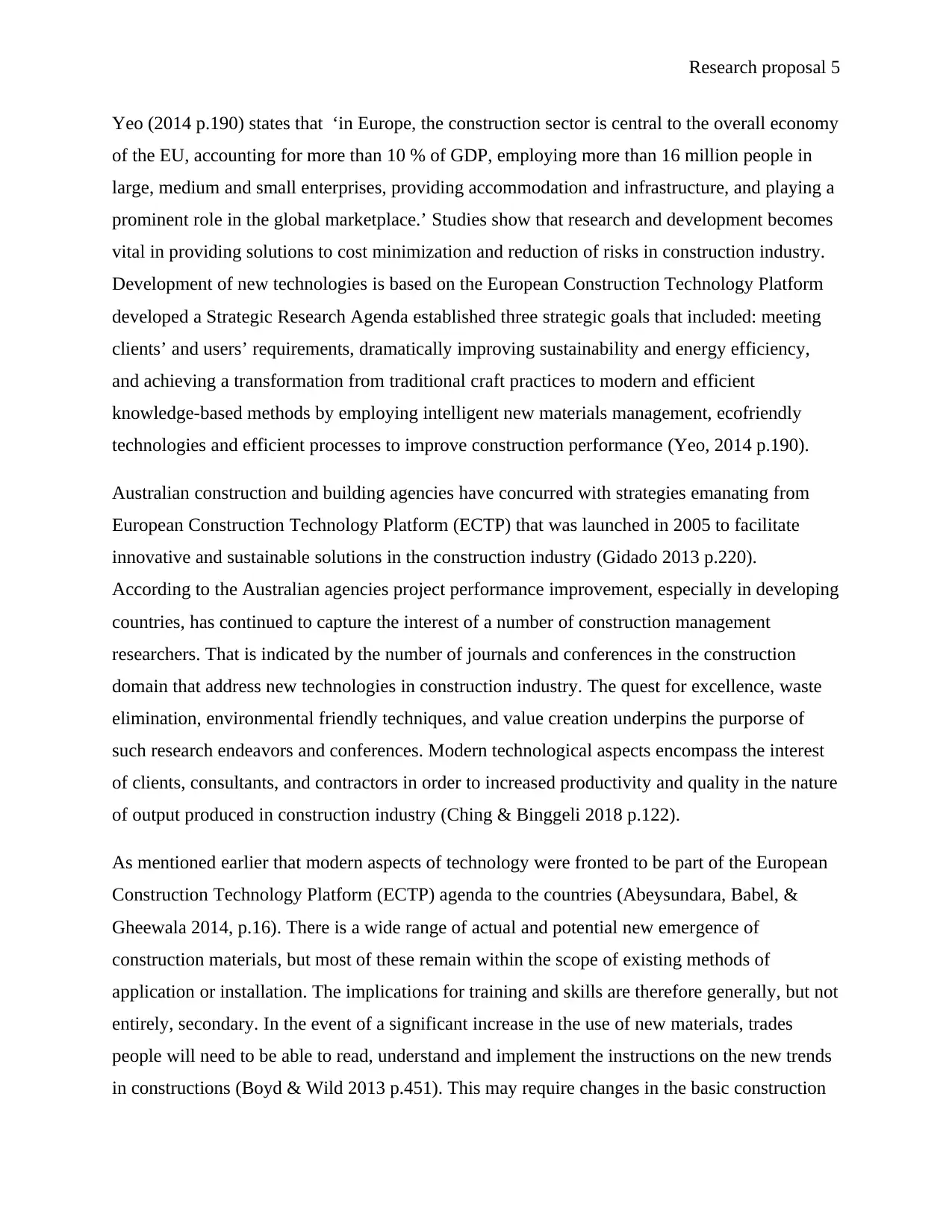
Research proposal 5
Yeo (2014 p.190) states that ‘in Europe, the construction sector is central to the overall economy
of the EU, accounting for more than 10 % of GDP, employing more than 16 million people in
large, medium and small enterprises, providing accommodation and infrastructure, and playing a
prominent role in the global marketplace.’ Studies show that research and development becomes
vital in providing solutions to cost minimization and reduction of risks in construction industry.
Development of new technologies is based on the European Construction Technology Platform
developed a Strategic Research Agenda established three strategic goals that included: meeting
clients’ and users’ requirements, dramatically improving sustainability and energy efficiency,
and achieving a transformation from traditional craft practices to modern and efficient
knowledge-based methods by employing intelligent new materials management, ecofriendly
technologies and efficient processes to improve construction performance (Yeo, 2014 p.190).
Australian construction and building agencies have concurred with strategies emanating from
European Construction Technology Platform (ECTP) that was launched in 2005 to facilitate
innovative and sustainable solutions in the construction industry (Gidado 2013 p.220).
According to the Australian agencies project performance improvement, especially in developing
countries, has continued to capture the interest of a number of construction management
researchers. That is indicated by the number of journals and conferences in the construction
domain that address new technologies in construction industry. The quest for excellence, waste
elimination, environmental friendly techniques, and value creation underpins the purporse of
such research endeavors and conferences. Modern technological aspects encompass the interest
of clients, consultants, and contractors in order to increased productivity and quality in the nature
of output produced in construction industry (Ching & Binggeli 2018 p.122).
As mentioned earlier that modern aspects of technology were fronted to be part of the European
Construction Technology Platform (ECTP) agenda to the countries (Abeysundara, Babel, &
Gheewala 2014, p.16). There is a wide range of actual and potential new emergence of
construction materials, but most of these remain within the scope of existing methods of
application or installation. The implications for training and skills are therefore generally, but not
entirely, secondary. In the event of a significant increase in the use of new materials, trades
people will need to be able to read, understand and implement the instructions on the new trends
in constructions (Boyd & Wild 2013 p.451). This may require changes in the basic construction
Yeo (2014 p.190) states that ‘in Europe, the construction sector is central to the overall economy
of the EU, accounting for more than 10 % of GDP, employing more than 16 million people in
large, medium and small enterprises, providing accommodation and infrastructure, and playing a
prominent role in the global marketplace.’ Studies show that research and development becomes
vital in providing solutions to cost minimization and reduction of risks in construction industry.
Development of new technologies is based on the European Construction Technology Platform
developed a Strategic Research Agenda established three strategic goals that included: meeting
clients’ and users’ requirements, dramatically improving sustainability and energy efficiency,
and achieving a transformation from traditional craft practices to modern and efficient
knowledge-based methods by employing intelligent new materials management, ecofriendly
technologies and efficient processes to improve construction performance (Yeo, 2014 p.190).
Australian construction and building agencies have concurred with strategies emanating from
European Construction Technology Platform (ECTP) that was launched in 2005 to facilitate
innovative and sustainable solutions in the construction industry (Gidado 2013 p.220).
According to the Australian agencies project performance improvement, especially in developing
countries, has continued to capture the interest of a number of construction management
researchers. That is indicated by the number of journals and conferences in the construction
domain that address new technologies in construction industry. The quest for excellence, waste
elimination, environmental friendly techniques, and value creation underpins the purporse of
such research endeavors and conferences. Modern technological aspects encompass the interest
of clients, consultants, and contractors in order to increased productivity and quality in the nature
of output produced in construction industry (Ching & Binggeli 2018 p.122).
As mentioned earlier that modern aspects of technology were fronted to be part of the European
Construction Technology Platform (ECTP) agenda to the countries (Abeysundara, Babel, &
Gheewala 2014, p.16). There is a wide range of actual and potential new emergence of
construction materials, but most of these remain within the scope of existing methods of
application or installation. The implications for training and skills are therefore generally, but not
entirely, secondary. In the event of a significant increase in the use of new materials, trades
people will need to be able to read, understand and implement the instructions on the new trends
in constructions (Boyd & Wild 2013 p.451). This may require changes in the basic construction
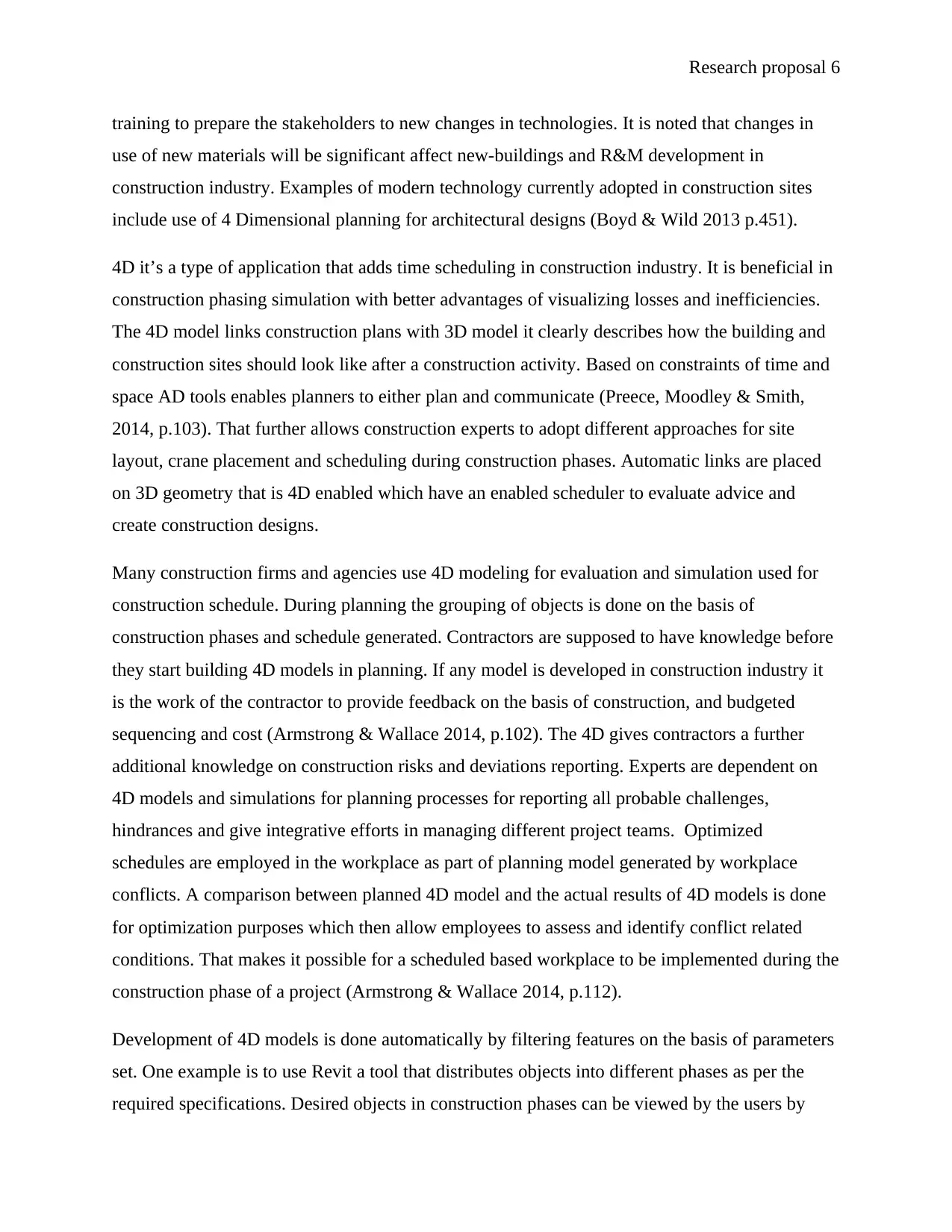
Research proposal 6
training to prepare the stakeholders to new changes in technologies. It is noted that changes in
use of new materials will be significant affect new-buildings and R&M development in
construction industry. Examples of modern technology currently adopted in construction sites
include use of 4 Dimensional planning for architectural designs (Boyd & Wild 2013 p.451).
4D it’s a type of application that adds time scheduling in construction industry. It is beneficial in
construction phasing simulation with better advantages of visualizing losses and inefficiencies.
The 4D model links construction plans with 3D model it clearly describes how the building and
construction sites should look like after a construction activity. Based on constraints of time and
space AD tools enables planners to either plan and communicate (Preece, Moodley & Smith,
2014, p.103). That further allows construction experts to adopt different approaches for site
layout, crane placement and scheduling during construction phases. Automatic links are placed
on 3D geometry that is 4D enabled which have an enabled scheduler to evaluate advice and
create construction designs.
Many construction firms and agencies use 4D modeling for evaluation and simulation used for
construction schedule. During planning the grouping of objects is done on the basis of
construction phases and schedule generated. Contractors are supposed to have knowledge before
they start building 4D models in planning. If any model is developed in construction industry it
is the work of the contractor to provide feedback on the basis of construction, and budgeted
sequencing and cost (Armstrong & Wallace 2014, p.102). The 4D gives contractors a further
additional knowledge on construction risks and deviations reporting. Experts are dependent on
4D models and simulations for planning processes for reporting all probable challenges,
hindrances and give integrative efforts in managing different project teams. Optimized
schedules are employed in the workplace as part of planning model generated by workplace
conflicts. A comparison between planned 4D model and the actual results of 4D models is done
for optimization purposes which then allow employees to assess and identify conflict related
conditions. That makes it possible for a scheduled based workplace to be implemented during the
construction phase of a project (Armstrong & Wallace 2014, p.112).
Development of 4D models is done automatically by filtering features on the basis of parameters
set. One example is to use Revit a tool that distributes objects into different phases as per the
required specifications. Desired objects in construction phases can be viewed by the users by
training to prepare the stakeholders to new changes in technologies. It is noted that changes in
use of new materials will be significant affect new-buildings and R&M development in
construction industry. Examples of modern technology currently adopted in construction sites
include use of 4 Dimensional planning for architectural designs (Boyd & Wild 2013 p.451).
4D it’s a type of application that adds time scheduling in construction industry. It is beneficial in
construction phasing simulation with better advantages of visualizing losses and inefficiencies.
The 4D model links construction plans with 3D model it clearly describes how the building and
construction sites should look like after a construction activity. Based on constraints of time and
space AD tools enables planners to either plan and communicate (Preece, Moodley & Smith,
2014, p.103). That further allows construction experts to adopt different approaches for site
layout, crane placement and scheduling during construction phases. Automatic links are placed
on 3D geometry that is 4D enabled which have an enabled scheduler to evaluate advice and
create construction designs.
Many construction firms and agencies use 4D modeling for evaluation and simulation used for
construction schedule. During planning the grouping of objects is done on the basis of
construction phases and schedule generated. Contractors are supposed to have knowledge before
they start building 4D models in planning. If any model is developed in construction industry it
is the work of the contractor to provide feedback on the basis of construction, and budgeted
sequencing and cost (Armstrong & Wallace 2014, p.102). The 4D gives contractors a further
additional knowledge on construction risks and deviations reporting. Experts are dependent on
4D models and simulations for planning processes for reporting all probable challenges,
hindrances and give integrative efforts in managing different project teams. Optimized
schedules are employed in the workplace as part of planning model generated by workplace
conflicts. A comparison between planned 4D model and the actual results of 4D models is done
for optimization purposes which then allow employees to assess and identify conflict related
conditions. That makes it possible for a scheduled based workplace to be implemented during the
construction phase of a project (Armstrong & Wallace 2014, p.112).
Development of 4D models is done automatically by filtering features on the basis of parameters
set. One example is to use Revit a tool that distributes objects into different phases as per the
required specifications. Desired objects in construction phases can be viewed by the users by
⊘ This is a preview!⊘
Do you want full access?
Subscribe today to unlock all pages.

Trusted by 1+ million students worldwide
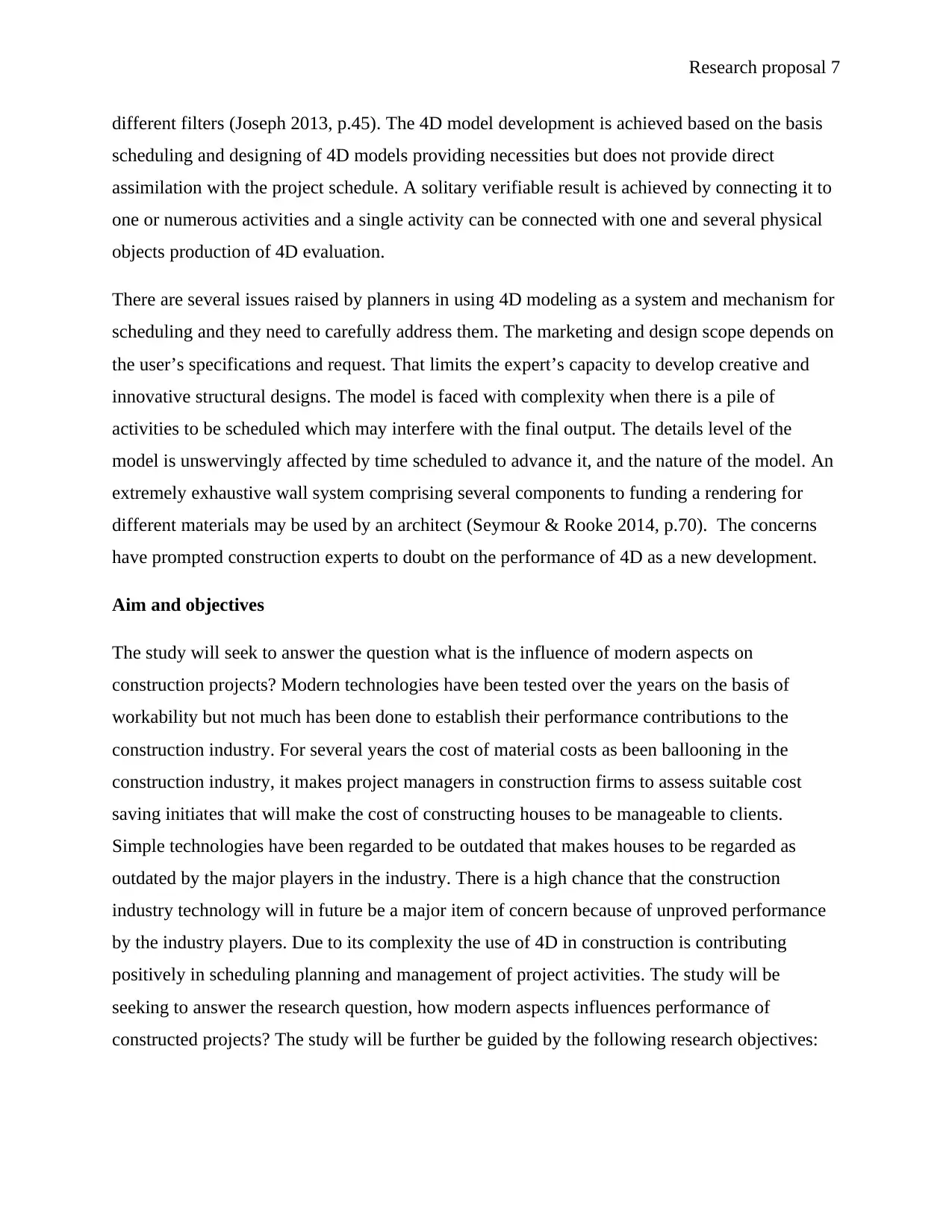
Research proposal 7
different filters (Joseph 2013, p.45). The 4D model development is achieved based on the basis
scheduling and designing of 4D models providing necessities but does not provide direct
assimilation with the project schedule. A solitary verifiable result is achieved by connecting it to
one or numerous activities and a single activity can be connected with one and several physical
objects production of 4D evaluation.
There are several issues raised by planners in using 4D modeling as a system and mechanism for
scheduling and they need to carefully address them. The marketing and design scope depends on
the user’s specifications and request. That limits the expert’s capacity to develop creative and
innovative structural designs. The model is faced with complexity when there is a pile of
activities to be scheduled which may interfere with the final output. The details level of the
model is unswervingly affected by time scheduled to advance it, and the nature of the model. An
extremely exhaustive wall system comprising several components to funding a rendering for
different materials may be used by an architect (Seymour & Rooke 2014, p.70). The concerns
have prompted construction experts to doubt on the performance of 4D as a new development.
Aim and objectives
The study will seek to answer the question what is the influence of modern aspects on
construction projects? Modern technologies have been tested over the years on the basis of
workability but not much has been done to establish their performance contributions to the
construction industry. For several years the cost of material costs as been ballooning in the
construction industry, it makes project managers in construction firms to assess suitable cost
saving initiates that will make the cost of constructing houses to be manageable to clients.
Simple technologies have been regarded to be outdated that makes houses to be regarded as
outdated by the major players in the industry. There is a high chance that the construction
industry technology will in future be a major item of concern because of unproved performance
by the industry players. Due to its complexity the use of 4D in construction is contributing
positively in scheduling planning and management of project activities. The study will be
seeking to answer the research question, how modern aspects influences performance of
constructed projects? The study will be further be guided by the following research objectives:
different filters (Joseph 2013, p.45). The 4D model development is achieved based on the basis
scheduling and designing of 4D models providing necessities but does not provide direct
assimilation with the project schedule. A solitary verifiable result is achieved by connecting it to
one or numerous activities and a single activity can be connected with one and several physical
objects production of 4D evaluation.
There are several issues raised by planners in using 4D modeling as a system and mechanism for
scheduling and they need to carefully address them. The marketing and design scope depends on
the user’s specifications and request. That limits the expert’s capacity to develop creative and
innovative structural designs. The model is faced with complexity when there is a pile of
activities to be scheduled which may interfere with the final output. The details level of the
model is unswervingly affected by time scheduled to advance it, and the nature of the model. An
extremely exhaustive wall system comprising several components to funding a rendering for
different materials may be used by an architect (Seymour & Rooke 2014, p.70). The concerns
have prompted construction experts to doubt on the performance of 4D as a new development.
Aim and objectives
The study will seek to answer the question what is the influence of modern aspects on
construction projects? Modern technologies have been tested over the years on the basis of
workability but not much has been done to establish their performance contributions to the
construction industry. For several years the cost of material costs as been ballooning in the
construction industry, it makes project managers in construction firms to assess suitable cost
saving initiates that will make the cost of constructing houses to be manageable to clients.
Simple technologies have been regarded to be outdated that makes houses to be regarded as
outdated by the major players in the industry. There is a high chance that the construction
industry technology will in future be a major item of concern because of unproved performance
by the industry players. Due to its complexity the use of 4D in construction is contributing
positively in scheduling planning and management of project activities. The study will be
seeking to answer the research question, how modern aspects influences performance of
constructed projects? The study will be further be guided by the following research objectives:
Paraphrase This Document
Need a fresh take? Get an instant paraphrase of this document with our AI Paraphraser
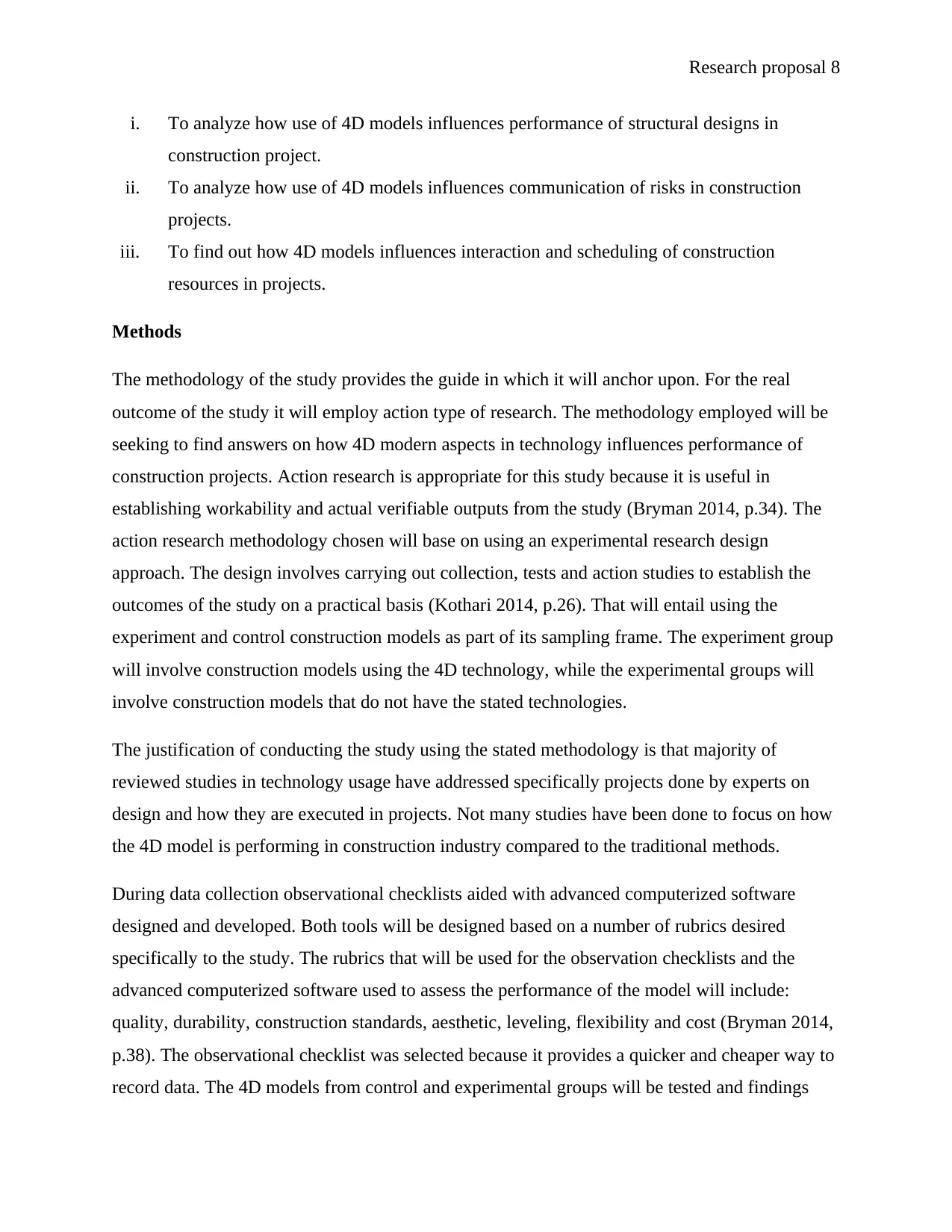
Research proposal 8
i. To analyze how use of 4D models influences performance of structural designs in
construction project.
ii. To analyze how use of 4D models influences communication of risks in construction
projects.
iii. To find out how 4D models influences interaction and scheduling of construction
resources in projects.
Methods
The methodology of the study provides the guide in which it will anchor upon. For the real
outcome of the study it will employ action type of research. The methodology employed will be
seeking to find answers on how 4D modern aspects in technology influences performance of
construction projects. Action research is appropriate for this study because it is useful in
establishing workability and actual verifiable outputs from the study (Bryman 2014, p.34). The
action research methodology chosen will base on using an experimental research design
approach. The design involves carrying out collection, tests and action studies to establish the
outcomes of the study on a practical basis (Kothari 2014, p.26). That will entail using the
experiment and control construction models as part of its sampling frame. The experiment group
will involve construction models using the 4D technology, while the experimental groups will
involve construction models that do not have the stated technologies.
The justification of conducting the study using the stated methodology is that majority of
reviewed studies in technology usage have addressed specifically projects done by experts on
design and how they are executed in projects. Not many studies have been done to focus on how
the 4D model is performing in construction industry compared to the traditional methods.
During data collection observational checklists aided with advanced computerized software
designed and developed. Both tools will be designed based on a number of rubrics desired
specifically to the study. The rubrics that will be used for the observation checklists and the
advanced computerized software used to assess the performance of the model will include:
quality, durability, construction standards, aesthetic, leveling, flexibility and cost (Bryman 2014,
p.38). The observational checklist was selected because it provides a quicker and cheaper way to
record data. The 4D models from control and experimental groups will be tested and findings
i. To analyze how use of 4D models influences performance of structural designs in
construction project.
ii. To analyze how use of 4D models influences communication of risks in construction
projects.
iii. To find out how 4D models influences interaction and scheduling of construction
resources in projects.
Methods
The methodology of the study provides the guide in which it will anchor upon. For the real
outcome of the study it will employ action type of research. The methodology employed will be
seeking to find answers on how 4D modern aspects in technology influences performance of
construction projects. Action research is appropriate for this study because it is useful in
establishing workability and actual verifiable outputs from the study (Bryman 2014, p.34). The
action research methodology chosen will base on using an experimental research design
approach. The design involves carrying out collection, tests and action studies to establish the
outcomes of the study on a practical basis (Kothari 2014, p.26). That will entail using the
experiment and control construction models as part of its sampling frame. The experiment group
will involve construction models using the 4D technology, while the experimental groups will
involve construction models that do not have the stated technologies.
The justification of conducting the study using the stated methodology is that majority of
reviewed studies in technology usage have addressed specifically projects done by experts on
design and how they are executed in projects. Not many studies have been done to focus on how
the 4D model is performing in construction industry compared to the traditional methods.
During data collection observational checklists aided with advanced computerized software
designed and developed. Both tools will be designed based on a number of rubrics desired
specifically to the study. The rubrics that will be used for the observation checklists and the
advanced computerized software used to assess the performance of the model will include:
quality, durability, construction standards, aesthetic, leveling, flexibility and cost (Bryman 2014,
p.38). The observational checklist was selected because it provides a quicker and cheaper way to
record data. The 4D models from control and experimental groups will be tested and findings
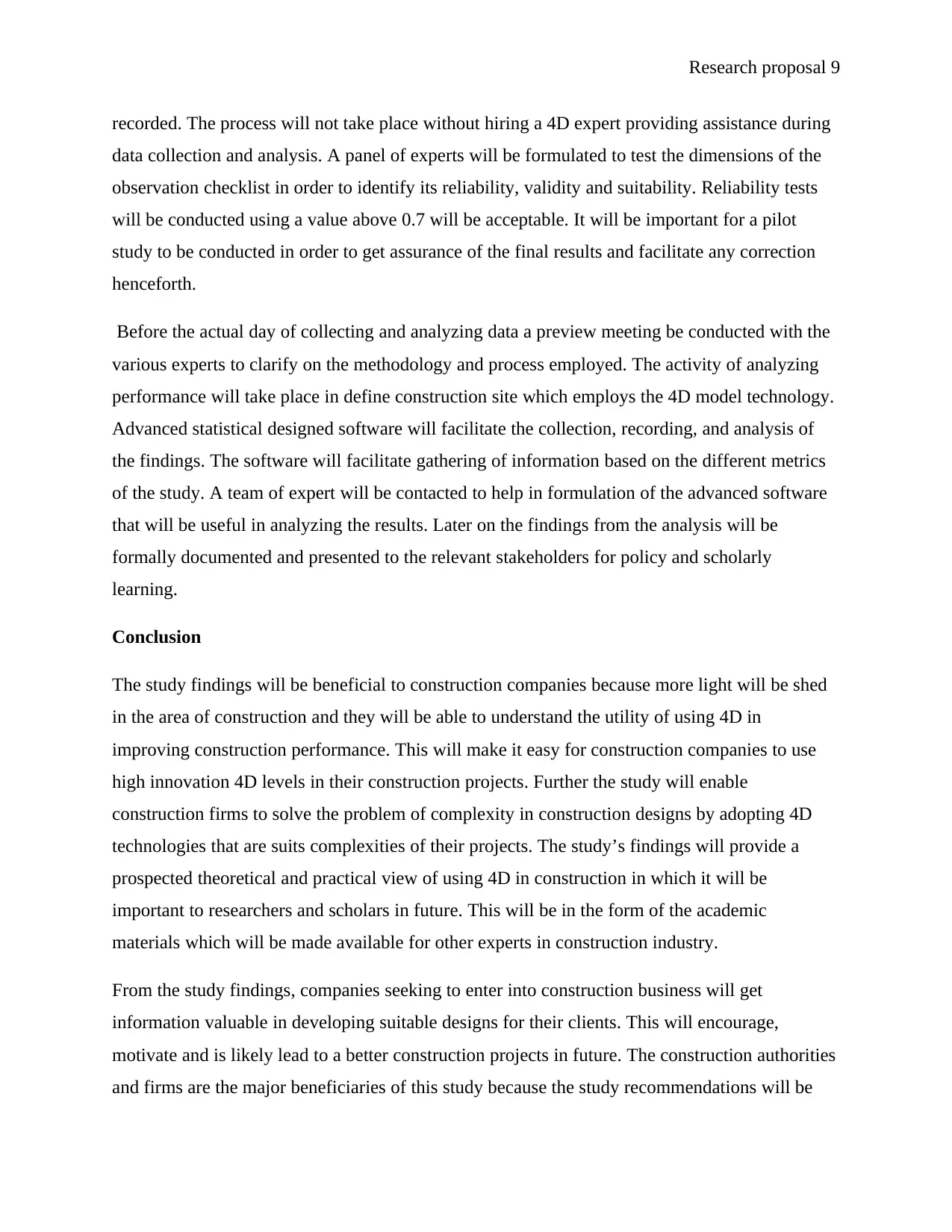
Research proposal 9
recorded. The process will not take place without hiring a 4D expert providing assistance during
data collection and analysis. A panel of experts will be formulated to test the dimensions of the
observation checklist in order to identify its reliability, validity and suitability. Reliability tests
will be conducted using a value above 0.7 will be acceptable. It will be important for a pilot
study to be conducted in order to get assurance of the final results and facilitate any correction
henceforth.
Before the actual day of collecting and analyzing data a preview meeting be conducted with the
various experts to clarify on the methodology and process employed. The activity of analyzing
performance will take place in define construction site which employs the 4D model technology.
Advanced statistical designed software will facilitate the collection, recording, and analysis of
the findings. The software will facilitate gathering of information based on the different metrics
of the study. A team of expert will be contacted to help in formulation of the advanced software
that will be useful in analyzing the results. Later on the findings from the analysis will be
formally documented and presented to the relevant stakeholders for policy and scholarly
learning.
Conclusion
The study findings will be beneficial to construction companies because more light will be shed
in the area of construction and they will be able to understand the utility of using 4D in
improving construction performance. This will make it easy for construction companies to use
high innovation 4D levels in their construction projects. Further the study will enable
construction firms to solve the problem of complexity in construction designs by adopting 4D
technologies that are suits complexities of their projects. The study’s findings will provide a
prospected theoretical and practical view of using 4D in construction in which it will be
important to researchers and scholars in future. This will be in the form of the academic
materials which will be made available for other experts in construction industry.
From the study findings, companies seeking to enter into construction business will get
information valuable in developing suitable designs for their clients. This will encourage,
motivate and is likely lead to a better construction projects in future. The construction authorities
and firms are the major beneficiaries of this study because the study recommendations will be
recorded. The process will not take place without hiring a 4D expert providing assistance during
data collection and analysis. A panel of experts will be formulated to test the dimensions of the
observation checklist in order to identify its reliability, validity and suitability. Reliability tests
will be conducted using a value above 0.7 will be acceptable. It will be important for a pilot
study to be conducted in order to get assurance of the final results and facilitate any correction
henceforth.
Before the actual day of collecting and analyzing data a preview meeting be conducted with the
various experts to clarify on the methodology and process employed. The activity of analyzing
performance will take place in define construction site which employs the 4D model technology.
Advanced statistical designed software will facilitate the collection, recording, and analysis of
the findings. The software will facilitate gathering of information based on the different metrics
of the study. A team of expert will be contacted to help in formulation of the advanced software
that will be useful in analyzing the results. Later on the findings from the analysis will be
formally documented and presented to the relevant stakeholders for policy and scholarly
learning.
Conclusion
The study findings will be beneficial to construction companies because more light will be shed
in the area of construction and they will be able to understand the utility of using 4D in
improving construction performance. This will make it easy for construction companies to use
high innovation 4D levels in their construction projects. Further the study will enable
construction firms to solve the problem of complexity in construction designs by adopting 4D
technologies that are suits complexities of their projects. The study’s findings will provide a
prospected theoretical and practical view of using 4D in construction in which it will be
important to researchers and scholars in future. This will be in the form of the academic
materials which will be made available for other experts in construction industry.
From the study findings, companies seeking to enter into construction business will get
information valuable in developing suitable designs for their clients. This will encourage,
motivate and is likely lead to a better construction projects in future. The construction authorities
and firms are the major beneficiaries of this study because the study recommendations will be
⊘ This is a preview!⊘
Do you want full access?
Subscribe today to unlock all pages.

Trusted by 1+ million students worldwide
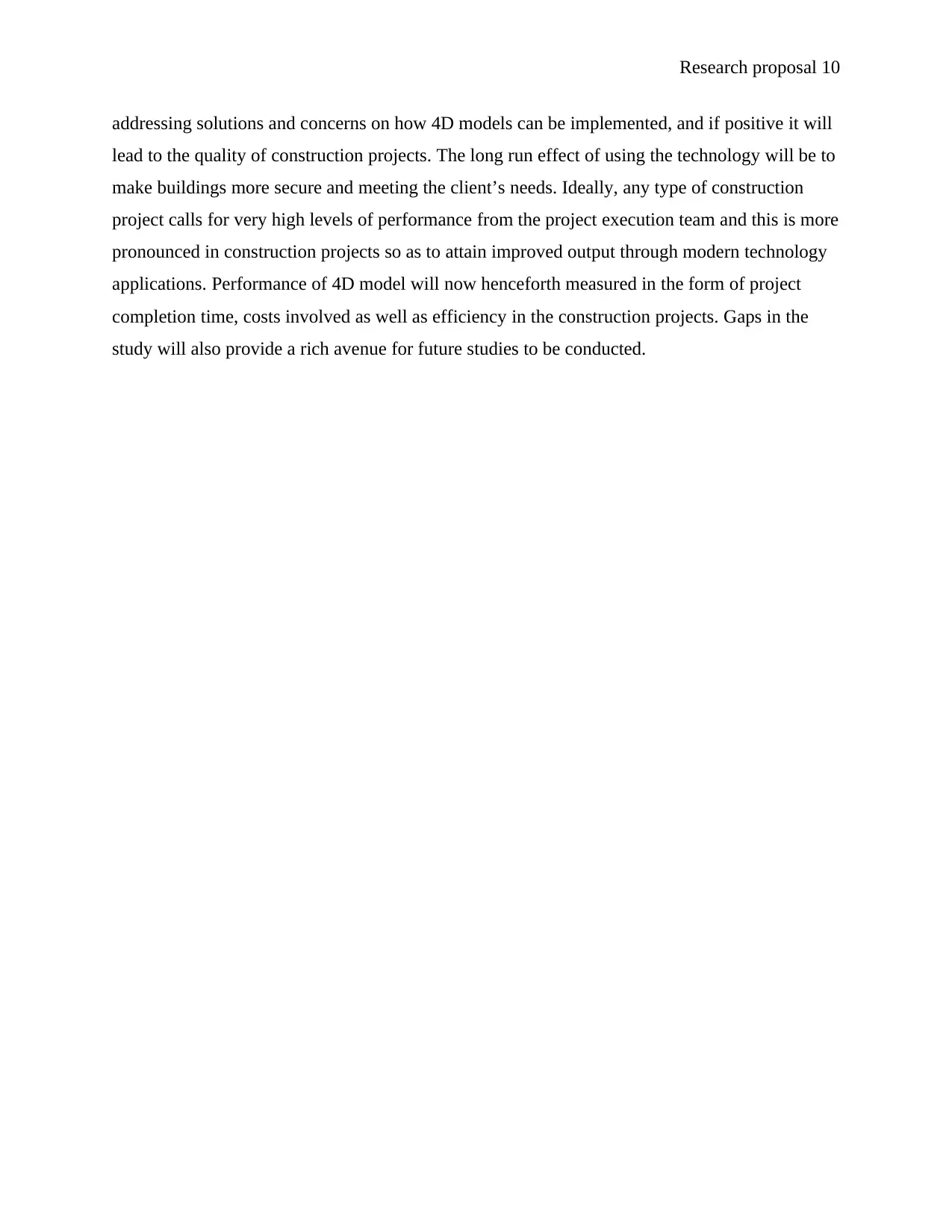
Research proposal 10
addressing solutions and concerns on how 4D models can be implemented, and if positive it will
lead to the quality of construction projects. The long run effect of using the technology will be to
make buildings more secure and meeting the client’s needs. Ideally, any type of construction
project calls for very high levels of performance from the project execution team and this is more
pronounced in construction projects so as to attain improved output through modern technology
applications. Performance of 4D model will now henceforth measured in the form of project
completion time, costs involved as well as efficiency in the construction projects. Gaps in the
study will also provide a rich avenue for future studies to be conducted.
addressing solutions and concerns on how 4D models can be implemented, and if positive it will
lead to the quality of construction projects. The long run effect of using the technology will be to
make buildings more secure and meeting the client’s needs. Ideally, any type of construction
project calls for very high levels of performance from the project execution team and this is more
pronounced in construction projects so as to attain improved output through modern technology
applications. Performance of 4D model will now henceforth measured in the form of project
completion time, costs involved as well as efficiency in the construction projects. Gaps in the
study will also provide a rich avenue for future studies to be conducted.
Paraphrase This Document
Need a fresh take? Get an instant paraphrase of this document with our AI Paraphraser
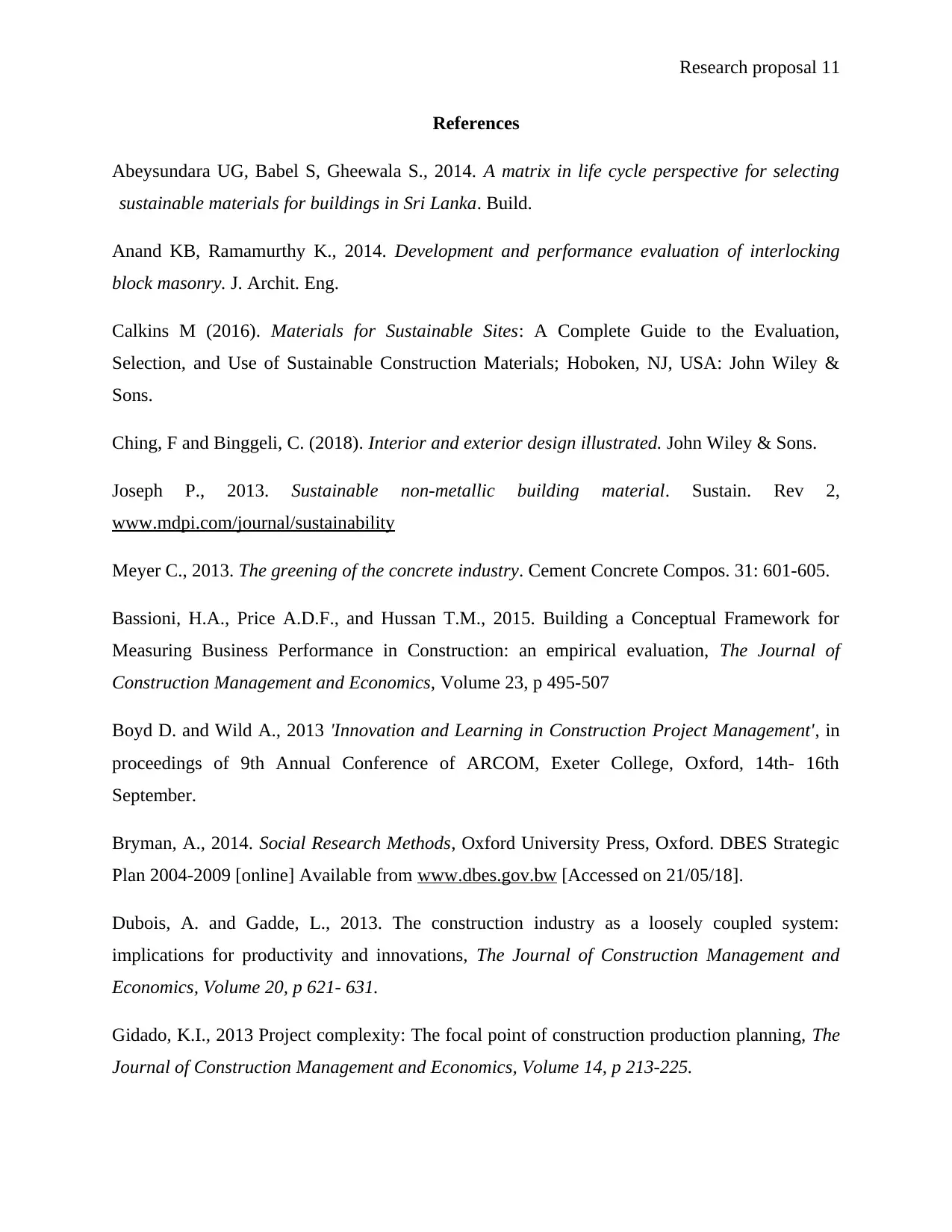
Research proposal 11
References
Abeysundara UG, Babel S, Gheewala S., 2014. A matrix in life cycle perspective for selecting
sustainable materials for buildings in Sri Lanka. Build.
Anand KB, Ramamurthy K., 2014. Development and performance evaluation of interlocking
block masonry. J. Archit. Eng.
Calkins M (2016). Materials for Sustainable Sites: A Complete Guide to the Evaluation,
Selection, and Use of Sustainable Construction Materials; Hoboken, NJ, USA: John Wiley &
Sons.
Ching, F and Binggeli, C. (2018). Interior and exterior design illustrated. John Wiley & Sons.
Joseph P., 2013. Sustainable non-metallic building material. Sustain. Rev 2,
www.mdpi.com/journal/sustainability
Meyer C., 2013. The greening of the concrete industry. Cement Concrete Compos. 31: 601-605.
Bassioni, H.A., Price A.D.F., and Hussan T.M., 2015. Building a Conceptual Framework for
Measuring Business Performance in Construction: an empirical evaluation, The Journal of
Construction Management and Economics, Volume 23, p 495-507
Boyd D. and Wild A., 2013 'Innovation and Learning in Construction Project Management', in
proceedings of 9th Annual Conference of ARCOM, Exeter College, Oxford, 14th- 16th
September.
Bryman, A., 2014. Social Research Methods, Oxford University Press, Oxford. DBES Strategic
Plan 2004-2009 [online] Available from www.dbes.gov.bw [Accessed on 21/05/18].
Dubois, A. and Gadde, L., 2013. The construction industry as a loosely coupled system:
implications for productivity and innovations, The Journal of Construction Management and
Economics, Volume 20, p 621- 631.
Gidado, K.I., 2013 Project complexity: The focal point of construction production planning, The
Journal of Construction Management and Economics, Volume 14, p 213-225.
References
Abeysundara UG, Babel S, Gheewala S., 2014. A matrix in life cycle perspective for selecting
sustainable materials for buildings in Sri Lanka. Build.
Anand KB, Ramamurthy K., 2014. Development and performance evaluation of interlocking
block masonry. J. Archit. Eng.
Calkins M (2016). Materials for Sustainable Sites: A Complete Guide to the Evaluation,
Selection, and Use of Sustainable Construction Materials; Hoboken, NJ, USA: John Wiley &
Sons.
Ching, F and Binggeli, C. (2018). Interior and exterior design illustrated. John Wiley & Sons.
Joseph P., 2013. Sustainable non-metallic building material. Sustain. Rev 2,
www.mdpi.com/journal/sustainability
Meyer C., 2013. The greening of the concrete industry. Cement Concrete Compos. 31: 601-605.
Bassioni, H.A., Price A.D.F., and Hussan T.M., 2015. Building a Conceptual Framework for
Measuring Business Performance in Construction: an empirical evaluation, The Journal of
Construction Management and Economics, Volume 23, p 495-507
Boyd D. and Wild A., 2013 'Innovation and Learning in Construction Project Management', in
proceedings of 9th Annual Conference of ARCOM, Exeter College, Oxford, 14th- 16th
September.
Bryman, A., 2014. Social Research Methods, Oxford University Press, Oxford. DBES Strategic
Plan 2004-2009 [online] Available from www.dbes.gov.bw [Accessed on 21/05/18].
Dubois, A. and Gadde, L., 2013. The construction industry as a loosely coupled system:
implications for productivity and innovations, The Journal of Construction Management and
Economics, Volume 20, p 621- 631.
Gidado, K.I., 2013 Project complexity: The focal point of construction production planning, The
Journal of Construction Management and Economics, Volume 14, p 213-225.
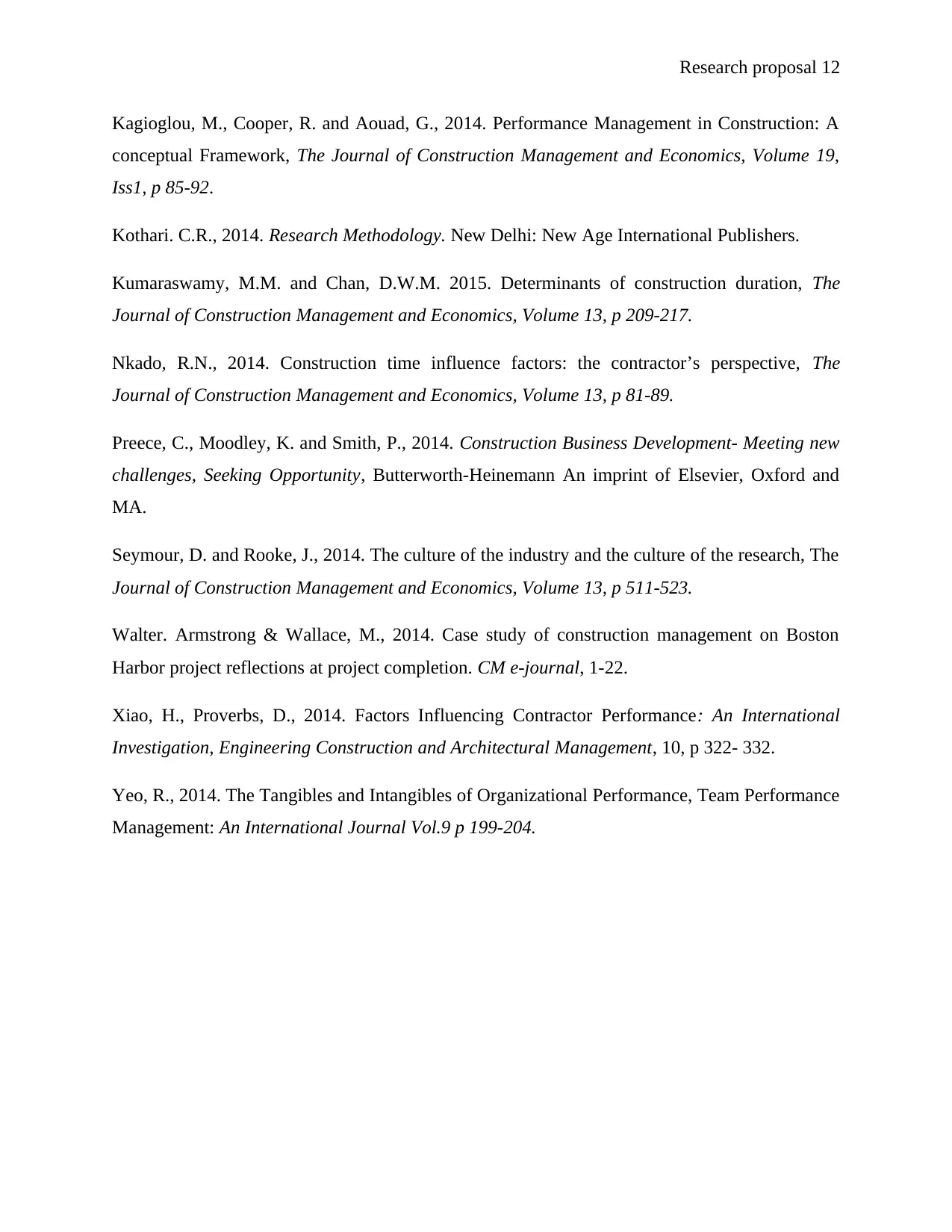
Research proposal 12
Kagioglou, M., Cooper, R. and Aouad, G., 2014. Performance Management in Construction: A
conceptual Framework, The Journal of Construction Management and Economics, Volume 19,
Iss1, p 85-92.
Kothari. C.R., 2014. Research Methodology. New Delhi: New Age International Publishers.
Kumaraswamy, M.M. and Chan, D.W.M. 2015. Determinants of construction duration, The
Journal of Construction Management and Economics, Volume 13, p 209-217.
Nkado, R.N., 2014. Construction time influence factors: the contractor’s perspective, The
Journal of Construction Management and Economics, Volume 13, p 81-89.
Preece, C., Moodley, K. and Smith, P., 2014. Construction Business Development- Meeting new
challenges, Seeking Opportunity, Butterworth-Heinemann An imprint of Elsevier, Oxford and
MA.
Seymour, D. and Rooke, J., 2014. The culture of the industry and the culture of the research, The
Journal of Construction Management and Economics, Volume 13, p 511-523.
Walter. Armstrong & Wallace, M., 2014. Case study of construction management on Boston
Harbor project reflections at project completion. CM e-journal, 1-22.
Xiao, H., Proverbs, D., 2014. Factors Influencing Contractor Performance: An International
Investigation, Engineering Construction and Architectural Management, 10, p 322- 332.
Yeo, R., 2014. The Tangibles and Intangibles of Organizational Performance, Team Performance
Management: An International Journal Vol.9 p 199-204.
Kagioglou, M., Cooper, R. and Aouad, G., 2014. Performance Management in Construction: A
conceptual Framework, The Journal of Construction Management and Economics, Volume 19,
Iss1, p 85-92.
Kothari. C.R., 2014. Research Methodology. New Delhi: New Age International Publishers.
Kumaraswamy, M.M. and Chan, D.W.M. 2015. Determinants of construction duration, The
Journal of Construction Management and Economics, Volume 13, p 209-217.
Nkado, R.N., 2014. Construction time influence factors: the contractor’s perspective, The
Journal of Construction Management and Economics, Volume 13, p 81-89.
Preece, C., Moodley, K. and Smith, P., 2014. Construction Business Development- Meeting new
challenges, Seeking Opportunity, Butterworth-Heinemann An imprint of Elsevier, Oxford and
MA.
Seymour, D. and Rooke, J., 2014. The culture of the industry and the culture of the research, The
Journal of Construction Management and Economics, Volume 13, p 511-523.
Walter. Armstrong & Wallace, M., 2014. Case study of construction management on Boston
Harbor project reflections at project completion. CM e-journal, 1-22.
Xiao, H., Proverbs, D., 2014. Factors Influencing Contractor Performance: An International
Investigation, Engineering Construction and Architectural Management, 10, p 322- 332.
Yeo, R., 2014. The Tangibles and Intangibles of Organizational Performance, Team Performance
Management: An International Journal Vol.9 p 199-204.
⊘ This is a preview!⊘
Do you want full access?
Subscribe today to unlock all pages.

Trusted by 1+ million students worldwide
1 out of 12
Related Documents
Your All-in-One AI-Powered Toolkit for Academic Success.
+13062052269
info@desklib.com
Available 24*7 on WhatsApp / Email
![[object Object]](/_next/static/media/star-bottom.7253800d.svg)
Unlock your academic potential
Copyright © 2020–2025 A2Z Services. All Rights Reserved. Developed and managed by ZUCOL.





